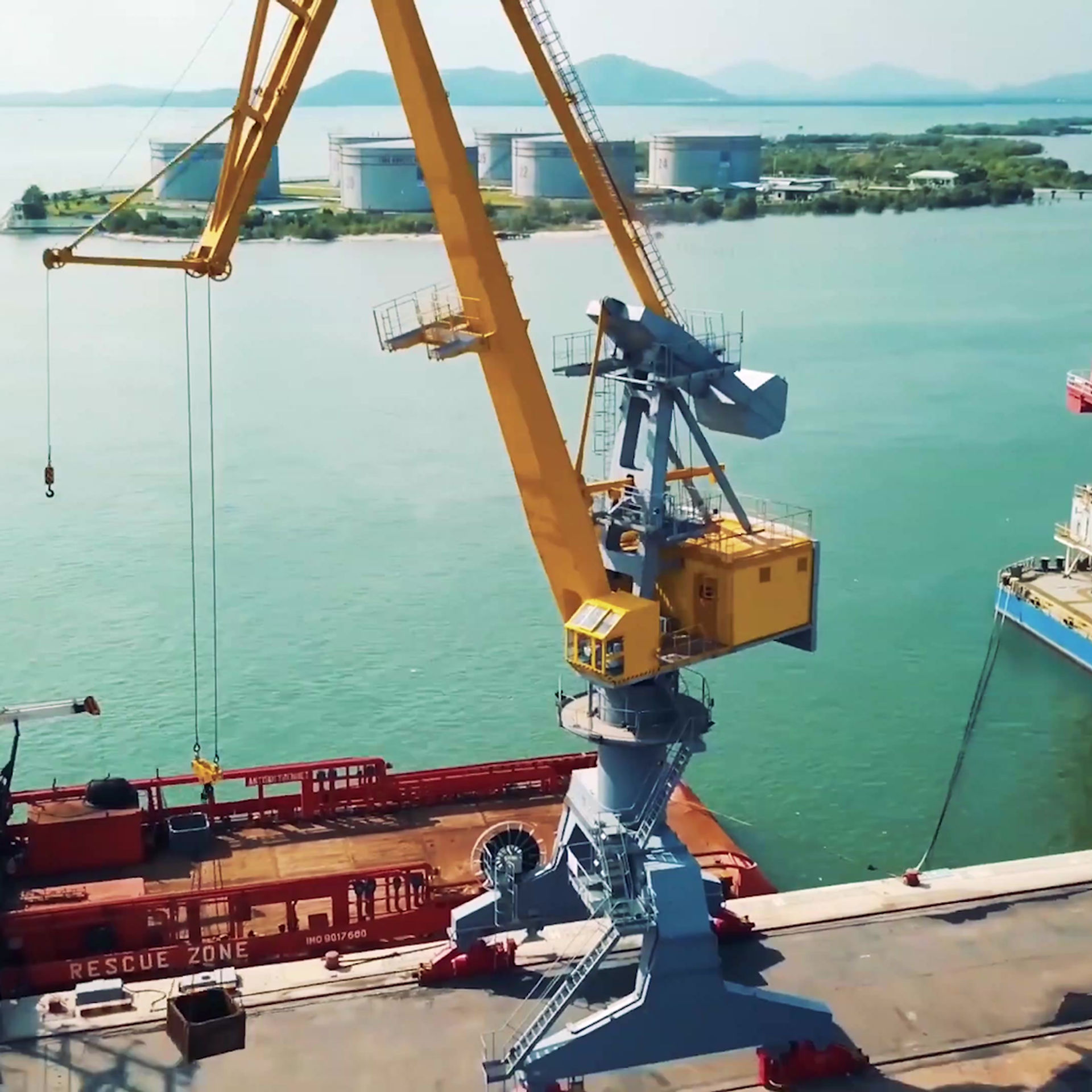
Bahasa
Klasifikasi Crane Tetap Dermaga
Terminal fixed cranes can be divided into: rack and pinion amplitude cranes and wire rope amplitude cranes according to the form of amplitude change. Rack and pinion amplitude cranes can be divided into: four-bar linkage combined boom cranes and single boom rack and pinion amplitude cranes. Wire rope amplitude cranes can be divided into: full-width load-bearing cranes and non-full-width load-bearing cranes. The crane can be equipped with hooks, grabs or container spreaders, electromagnetic suction cups and other lifting devices for operation, mainly used for seaports, river ports, and can also be used for yard and station operations.
Four-bar linkage combined boom crane: Four-bar linkage combined boom crane, mainly composed of boom, elephant nose beam, large pull rod combined four-bar boom system, rack and pinion amplitude mechanism, lever active counterweight balance, column, turntable, cylindrical base and other components. Use hooks or grabs for piece or bulk cargo loading and unloading operations, or use container spreaders for container loading and unloading operations. This model has the advantages of beautiful appearance, safe and reliable work, advanced performance, convenient maintenance, and durability. It can be widely used for loading and unloading operations at major port terminals. It is an ideal model for comprehensive port multi-cargo terminals. This model adopts AC frequency conversion speed regulation, PLC control, and can install intelligent “state monitoring and control system”. Advantages: large working range, fast speed, good overall stability, lifting, rotating and amplitude changing mechanisms can operate separately or in combination.
Disadvantages: the boom is a combined boom, complex structure, heavy weight, high manufacturing cost.
Single boom rack and pinion amplitude crane: Single boom rack and pinion amplitude crane, mainly composed of truss-type single boom, rack and pinion amplitude mechanism, lever active counterweight balance, column, turntable, cylindrical base and other components. Use hooks or grabs for piece or bulk cargo loading and unloading operations, or use container spreaders for container loading and unloading operations. This model has the advantages of beautiful appearance, safe and reliable work, advanced performance, convenient maintenance, and durability. It can be widely used for loading and unloading operations at major port terminals. It is an ideal model for comprehensive port multi-cargo terminals. This model adopts AC frequency conversion speed regulation, PLC control, and can install intelligent “state monitoring and control system”.
Advantages: light boom, fast speed, good overall stability, lifting, rotating and amplitude changing mechanisms can operate separately or in combination.
Disadvantages: the boom working range should not be too long, the horizontal displacement of the cargo needs to be compensated by the wire rope, which makes the mechanism layout complex and increases the wire rope wear.
Full-width load-bearing fixed crane: Full-width load-bearing fixed crane, mainly composed of truss-type single boom, compensation-type pulley group, column, turntable, cylindrical base and other components. Use hooks or grabs for piece or bulk cargo loading and unloading operations, or use electromagnetic suction cups for operation. This model has the advantages of beautiful appearance, safe and reliable work, advanced performance, convenient maintenance, and durability. It can be widely used for loading and unloading operations at major port terminals. It is an ideal model for comprehensive port multi-cargo terminals. This model adopts ACthree-phase asynchronous speed regulation, conventional control, and can install intelligent “state monitoring and control system”. The crane adopts a single lifting arm pulley group compensation balance device to ensure that the cargo moves along an approximate horizontal line during the amplitude change, which improves the operation accuracy. The amplitude change mechanism can carry out horizontal displacement with load, and the rotation mechanism can rotate at any angle. The whole machine can do lifting, amplitude change and rotation separately or in combination within the working range. Advantages: the pulley group compensation balance device ensures that the cargo moves approximately horizontally, the boom is light, the amplitude change power is small, the speed is fast, the overall stability is good, and the loading and unloading efficiency is high.
Disadvantages: the horizontal displacement of the cargo needs to be compensated by the wire rope, which makes the mechanism layout complex and increases the wire rope wear.
Non-full-width load-bearing fixed crane: Non-full-width load-bearing fixed crane, mainly composed of truss-type single boom, pulley group, A-frame, turntable, cylindrical base and other components. Use hooks or grabs for piece or bulk cargo loading and unloading operations, or use electromagnetic suction cups for operation. This model has the advantages of beautiful appearance, safe and reliable work, advanced performance, convenient maintenance, and durability. It can be widely used for loading and unloading operations at major port terminals. It is an ideal model for comprehensive port multi-cargo terminals. This model adopts three-phase asynchronous speed regulation, conventional control, and can install intelligent “state monitoring and control system”. The crane adopts a single lifting arm wire rope amplitude change form, which is flexible and convenient to operate, can perform frequent and continuous operations, has a low maintenance rate, and is economical and affordable.
Advantages: simple structure, easy operation, economical and affordable.
Disadvantages: during the amplitude change, the cargo center of gravity rises or falls, the amplitude change force is large, the motor power increases, and the loading and unloading efficiency is low.